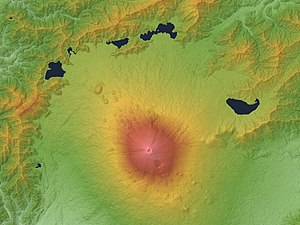| Aokigahara 青木ヶ原 (Japanese) | |
|---|---|
 Aokigahara, the Misaka Mountains and Saiko Lake, as seen from Mount Ryu of the Tenshi Mountains | |
 Aokigahara Mount Fuji  Locations of Aokigahara and Mount Fuji | |
| Ecology | |
| Realm | Palearctic |
| Biome | Temperate broadleaf and mixed forest |
| Geography | |
| Area | 35 km2 (14 sq mi) |
| Country | Japan |
| Prefecture | Yamanashi Prefecture |
| Coordinates | 35°28′12″N 138°37′11″E / 35.47000°N 138.61972°E |
| Conservation | |
| Conservation status | Relatively stable/Relatively intact |
Aokigahara (青木ヶ原, 'Blue Tree Meadow'), also known as the Sea of Trees (樹海, Jukai), is a forest on the northwestern flank of Mount Fuji on the island of Honshu in Japan, thriving on 30 square kilometres (12 sq mi) of hardened lava laid down by the last major eruption of Mount Fuji in 864 CE.[1] The western edge of Aokigahara, where there are several caves that fill with ice in winter, is a popular destination for tourists and school trips. Parts of Aokigahara are very dense, and the porous lava rock absorbs sound, contributing to a sense of solitude that some visitors attribute to the forest.[2]
The forest has a historical reputation as a home to yūrei: ghosts of the dead in Japanese mythology. At least since the 1960s, Aokigahara has become associated with suicide, eventually becoming known in English by the nickname "Suicide Forest" and gaining a reputation as one of the world's most-used suicide sites. Because of this, signs at the head of some trails urge suicidal visitors to think of their families and contact a suicide prevention association.
- ^ "The nature found in the Aokigahara 'sea of trees'". Yamanashi Kankou. Retrieved 21 January 2017.
- ^ Harrington, Patrick (22 January 2017). "Hiking in a Forest Born Out of Mount Fuji's Lava". The New York Times. p. TR8.